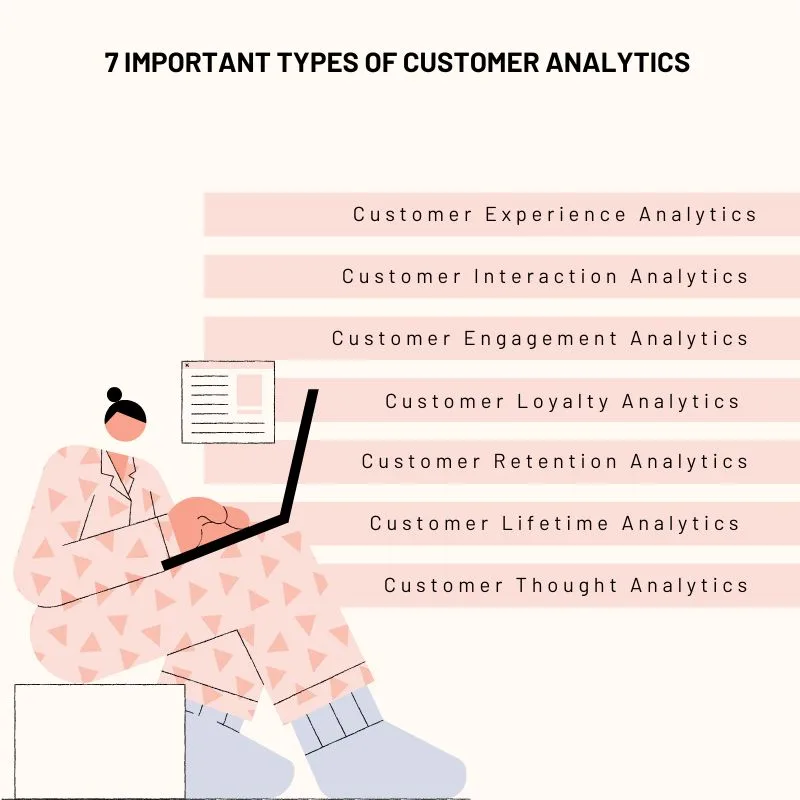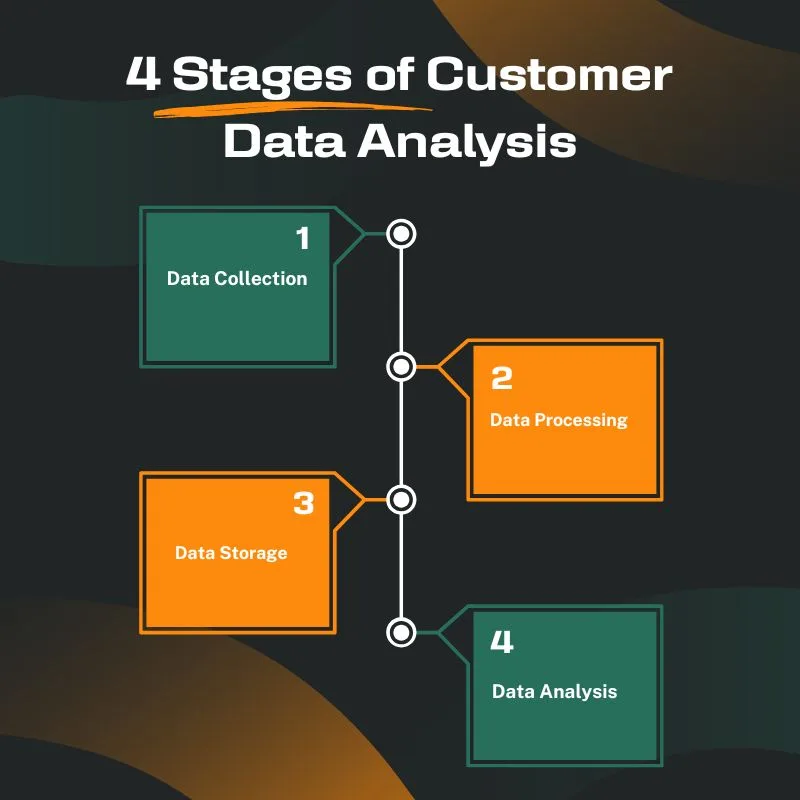What is Customer Analytics? Benefits, Types & Use Cases
- November 17, 2021
- 15 mins read
- Listen

Table of Content
Businesses get a vast amount of customer data from different communication touchpoints, but raw data alone doesn’t translate to actionable insights. This is where customer analytics step in, transforming data into a goldmine of information that can guide companies to design different strategies.
Customer analytics enables businesses to better understand customer behavior, preferences, and trends. With such insights, companies can tailor their offerings, improve customer satisfaction, and ultimately increase sales.
In this blog, we will explore the core concepts of customer analytics, why it is important for modern business strategies, and how you can use it to boost your organization’s performance.
We will cover:
- Definition of Customer Analytics?
- Benefits of Customer Analytics
- 7 Important Types of Customer Analytics
- 4 Stages of Customer Data Analysis
- How to Turn Customer Data into Business Opportunities
- Industry-specific Use Cases of Customer Analytics
What is Customer Analytics?
Customer analytics is the process of collecting and examining various data related to customer preferences and requirements to gain a deeper understanding of their behavior.
The idea behind using customer journey analytics is to segment buyers into relevant groups, understand behavior to determine general trends, and develop strategies for targeted marketing.
Regardless of the industry, the objective of customer data analytics remains consistent—gaining a clear understanding of customers at different stages of their journey and identifying high-value individuals for targeted engagement. With a wealth of accurate data, businesses can effortlessly gain insights, making it easier to offer what their customers want and increase sales.
Benefits of Customer Analytics
As per McKinsey’s report, the impact of customer analytics on corporate performance is huge. The use of customer behavior analytics can greatly impact various processes like pricing, promotion, and management. With such data, businesses can bolster their diverse customer-centric strategies and gain a holistic view of the customer. It will also help devise the right acquisition, retention as well as engagement strategies for the customers.
Let’s discuss these benefits in detail!
-
Better Customer Engagement
Customers are more engaged when the offers are relevant, and the communication is personalized. Analytics ensure that you identify customer needs better and engage them positively.
-
Increased Sales Conversions
A data-driven approach is always beneficial when it comes to reaching the right audience as then you can hit the bull’s eye and ensure a drive to conversion rate. Also, you can track your progress and performance in sales dashboards.
-
Reduced Customer Churn
Customer analytics enables businesses to find customers who are about to leave dissatisfied and implement proactive measures to retain them.
-
Better Decision Making
Relying on data rather than intuition allows businesses to make more informed decisions. For example, you can use data analytics to understand which campaigns are driving the most engagement and conversions and optimize those strategies accordingly.
-
Reduced Customer Acquisition Costs
With detailed customer data on preferences and behaviors in hand, you can acquire new customers more efficiently and cost-effectively. By understanding what appeals to different customer segments, companies can tailor their messaging and offers.
-
Business Growth
Customer Analytics provides valuable insights into customer preferences and market trends, enabling businesses to craft effective expansion strategies. Whether you want to explore new markets or launch innovative products, these insights help you to make informed, data-driven decisions.
7 Important Types of Customer Analytics
Customer mapping requires a lot of effort as various stages and touchpoints are involved. If there is no data, your business will find it hard to quantify, classify and categorize customers. There are 7 different types of client analytics and using them accurately can improve how you track the target audience successfully.
Next, let’s discuss these categories in detail!

7 Important Types of Customer Analytics
1. Customer Experience Analytics
Customer experience analytics is a form of descriptive analytics that gives insight into how your customers feel when they interact with a brand. The purpose of using these customer behavior analytics is to ask or know “what happened” during the customer journey.
With such data, it’s easy to summarize raw data into easy-to-understand and simple-to-explain concepts, which in turn, can help improve customer experience in the desired manner.
From where you can fetch customer experience analytics?
- Customer Satisfaction (CSAT): You can pull this key performance indicator from support data, view the existing workflow, and measure the performance of the team.
- First Response Time (FRT): To understand whether customers were/are served timely at different touchpoints, you can calculate the FRT by dividing the total of first response times by the number of cases resolved.
- Total Time to Resolution (TTR): Businesses can measure the TTR to see how their support agents are performing and based on that, can see where to make the due improvements.
2. Customer Interaction Analytics
Having a complete understanding of the customer journey is always crucial to providing a better customer experience. Since the journey is complex with various stages and multiple touchpoints, the focus should always be on knowing the complete customer interactions with the business.
From where you can fetch customer interaction analytics?
- Customer Engagement Tools: You can get detailed info on all the past interactions between your customers and support reps on various communication platforms.
- Social Media Comments: The kind of comments customers leave on social media can give a good insight what they expect from your business and this metric could also be used to adjust your roadmap and drive revenue.
- Product Page Traffic Data: Your business can use the traffic data to the product page to get a detailed understanding of the early stages of the customer journey, and also to get a peek into the research and information collection.
3. Customer Engagement Analytics
Customer data alone is never enough when it comes to developing a successful customer experience strategy. Your business also needs behavioral data from multiple channels to take timely actions and deliver personalized marketing messages. This is where customer engagement analytics help as they give actionable insights that help organizations respond to customer needs in a timely manner.
The purpose of customer engagement analytics is to help improve customer engagement by analyzing structured and unstructured customer data gathered from various channels. The data sets obtained from these analytics are helpful in understanding the quality of customer engagement and then boosting customer experience initiatives or driving marketing activities.
From where you can fetch customer engagement analytics?
- Customer Feedback Data: Your business needs to analyze customer feedback data from multiple touchpoints and communication channels. Then you need to integrate them to gain a holistic view of the buyer journey.
- Email Marketing Metrics: It’s easy to analyze the metrics like click rates and click-through rates to gain an insight into how to boost customer engagement across channels.
4. Customer Loyalty Analytics
A good experience can pave the way for long-term happy and loyal customers. To deliver such kinds of experience, you first need to have a good understanding of your customers. This is where customer loyalty analytics can help you as it can give an insight into buyers and then you can tailor the experience that matches their expectations.
If you want to develop customer-centric marketing strategies or aim to gain answers about customer behavior, you can always turn to customer loyalty analytics for the same.
From where you can get customer loyalty analytics?
- Qualitative Surveys: Surveys are always a good to get customer feedback and ask the exact questions you want answers for. Based on the surveys, you can get a clear image of customers’ loyalty to your brand.
- Online Reviews and Social Media Posts: When you plan to analyze customer loyalty, there is no better way than looking for online reviews and social media posts as they give a good insight into what customers think about your business.
5. Customer Retention Analytics
Acquiring new customers is as crucial as retaining the ones you already have. Since retaining customers costs a fraction of winning new ones, it always becomes important for organizations to know what makes customers stay or leave. Customer retention analytics help you to understand the reasons and factors responsible for customer retention and churn.
One of the key components of customer retention analytics is the statistical techniques that look at past data and predict future trends. It also involves tracking customers over a set period of time. Using customer retention analytics, it will be easy to identify sources and rates of customer churn among your customer segments.
From where you can get customer retention analytics?
- Measure LTV to CAC Ratio: You can use customer retention analytics to understand, and then achieve, the ratio between customer lifetime value (LTV) and customer acquisition costs (CAC)
- Churn Prevention Strategy: Using customer retention analytics is important for identifying high-value customers at risk of leaving and developing an effective strategy to prevent churn.
6. Customer Lifetime Analytics
For a business, it’s always important to know who your best customers are. When you have that data, the next step is to know how to retain the customers and maintain a long-lasting relationship with them. You should also understand the expected benefits those customers might bring during their lifecycle with your brand.
The Customer Lifetime Value (CLTV) is thus a key metric that helps you understand how much revenue to expect from a single customer throughout his/her stay with your business. Once you know the CLV for each customer, you can always utilize that metric effectively and optimize the marketing and sales accordingly.
Similarly, you can also segment this metric to identify other valuable customers and then target them with relevant marketing campaigns. If the CLTV is decreasing over a while, it means you have an issue with repeat customers. And if your CLTV is lower than the customer acquisition cost, it shows you are overspending on getting the customer back.
7. Customer Thought Analytics
Customers are important, and their feedback is equally valuable. Whether their opinions are positive or negative, they frequently share their thoughts about businesses. Ignoring what they say and where they say it would be a big mistake.
The idea behind tracking customer opinion is to know their thoughts and expectations so that you can always adjust your product offerings, marketing strategies and target them with the right offers. Anything that gives you a peek into the customer’s thoughts is always a great piece of data, so you must not ignore it.
How to get data on customer opinions?
- Devise a strategy to keep an eye on all the social media posts and interactions to know what customers think about your business.
- Run CSAT and NPS surveys, ask the right questions, and get insight into demographics to know customers better.
4 Stages of Customer Data Analysis
The process of collecting and storing customer data is a bit complex as it involves multiple stages, each critical to ensure data accuracy, security, and compliance. From identifying where to collect data to analyzing and utilizing insights for business growth, you need to understand the entire lifecycle of customer data management. Here are the 4 key stages of customer data collection to look into:
1. Data Collection
Gather information from multiple touchpoints, including websites, mobile apps, social media platforms, and customer surveys. These sources provide valuable insights into your customers’ preferences, behaviors, and needs, helping you tailor your product offerings and improve their overall experience.
Before collecting data, ensure you have obtained customer consent and comply with relevant data protection regulations such as GDPR or CCPA. Utilize various tools like forms, cookies, tracking pixels, and CRM systems to accurately capture and manage the data.
2. Data Processing
After collecting customer data, the next step is to sort and filter it to get the most relevant information. Organize the data into meaningful categories such as demographics, behavioral patterns, and transaction history. This structured approach helps you manage and analyze the data more efficiently.
Ensure data accuracy by removing duplicates, correcting errors, and validating information. Predictive analytics can further enhance your understanding by forecasting future customer behaviors and preferences.
3. Data Storage
Customer Data Platforms (CDPs) are specialized tools designed to securely store and manage customer data. These platforms enable you to consolidate all information from various sources, providing a unified view that makes it easier to analyze valuable insights.
To enhance scalability and accessibility, consider using cloud storage solutions. Additionally, prioritize security by implementing measures like encryption, access controls, and regular security audits to protect sensitive customer information.
4. Data Analysis
The final step is to analyze the data you have collected and stored, to make informed decisions for the betterment of your business and customers. Utilize different analytical tools and techniques to get info on customer preferences, behavior patterns, and potential future trends through predictive analytics. Present these insights using various dashboards and reports, for better decision-making.
Tools like REVE Chat, Google Analytics, and Adobe Analytics are great for understanding customer behavior on your website or app. These tools help you gain deeper insights into how users interact with your digital platforms, enabling you to design more targeted strategies for better customer engagement.
How to Turn Customer Data into Business Opportunities
With customer analytics, you can use data-driven insights to better understand your customers, optimize business strategies, and enhance overall customer experiences. Here’s how to apply customer analytics effectively:
-
Identify the Right Audience for Your Business
To identify your target audience, start by analyzing customer data and gather key insights about your most valuable customers. By examining the demographics, preferences, and behaviors, you can identify who your ideal customers are. This allows you to personalize your marketing efforts and resources toward reaching this specific group and ensures that your campaigns are more focused, relevant, and impactful.
-
Define Your Objectives
Start by setting clear goals for what you want to achieve with customer analytics, whether it’s improving customer retention, increasing sales, or personalizing marketing campaigns. Knowing your objectives will help you to prioritize.
-
Enhance Your Marketing Campaigns and Customer Service
Use the insights derived from customer analytics to refine and optimize your marketing efforts and offer personalized customer service. By understanding your customers’ choices and behaviors, you can create campaigns that are focused and relevant, ensuring they capture customer attention and drive higher engagement.
-
Monitor and Adjust Strategies
Always keep an eye on the performance of your strategies and campaigns. Customer behavior can change over time, so it’s important to monitor trends and adjust your approach accordingly to stay relevant and effective.
Industry-specific Use Cases of Customer Analytics
Every industry relies on customer data to gain insights into consumer behavior and predict future purchasing trends. With customer analytics, brands can better structure their engagement strategies and design upcoming offers/deals to meet customer expectations. Let’s explore how customer analytics help industries to optimize product offerings and elevate the customer experience.
-
Banking
Analytics can provide banks with more power and flexibility in terms of ensuring optimal performance and taking key decisions where timing is important. By analyzing vast datasets, banks can enhance performance and make informed decisions in key areas. Data sets can have a positive impact in areas such as calculating value, compliance, fraud, and NPA monitoring. This makes operations smoother, reduces risks, and improves the overall customer experience.
Also, customer analytics helps banks to understand their customers’ financial behavior. By analyzing various financial data, banks can tailor their services to meet individual needs. For example, if a customer’s data shows that he regular invests in stock markets, the bank can offer him/her a premium trading account with exclusive benefits, creating a more personalized banking experience.
-
eCommerce
In eCommerce, customer analytics helps to understand the browsing behaviour, buying patterns, and preferences of their target audience on websites, mobile apps or other social media platforms. By analyzing data such as past orders, purchase frequency, and product preferences, businesses can personalize recommendations and improve customer retention.
For example, if analytics show a customer frequently buys makeup products, the eCommerce platform can recommend related items, such as skin care products to enhance the overall shopping experience and increase the likelihood of additional sales.
-
Retail
The retail industry makes use of customer analytics to identify the target audience and ensure they offer the right things to the right audience.
Customer analytics helps businesses understand their customers’ purchasing behaviors. By analyzing customer data and in-store trends, retailers can create personalized and engaging marketing campaigns. For example, if data indicates that a group of customers often buy fitness equipment, retailers can design promotions featuring workout gear and accessories tailored to this segment.
-
Real Estate
Customer analytics helps real estate businesses identify what buyers or renters are looking for: property size, location, amenities, or price range. This insight allows agents and firms to find their clients with properties that meet their requirements and preferences.
By analyzing different data such as browsing behavior, inquiries, and engagement with their marketing materials, real estate firms identify high-potential leads. Analytics can also help segment audiences based on readiness to purchase so that real estate firms can offer customized property recommendations.
Wrapping Up!
Analytics has a big role to play in understanding customers, their tastes, and preferences in a detailed manner. And if you’re able to leverage that data well, it will always be easy for your business to achieve the kind of growth and success it deserves or anticipates.
To access predictive customer analytics, REVE Chat offers an excellent solution through its live chat and chatbot platform. These tools provide valuable insights into customer choices, enabling you to stay ahead of future challenges. By understanding your customers better, you can personalize their experience and provide top-notch service, ensuring long-term loyalty and satisfaction. And once you know the customer well, you can always serve them well. To know more, SIGN Up today!
Frequently Asked Questions
Voice of the Customer (VoC) Analytics refers to the process of collecting and analyzing customer feedback to gain insights into their experiences, expectations, and perceptions. You can collect such feedback from various sources, such as surveys, reviews, interviews, social media, customer service interactions, and more.
Customer insights are actionable understandings that you get by analyzing customer behavior, preferences, needs, and feedback. These insights help businesses make informed decisions to better meet customer expectations, improve experiences, and product offerings, and drive sales growth.
Gathering customer insights involves collecting data from various communication touchpoints and analyzing it to uncover patterns and actionable information. Some effective ways to gather customer insights are- surveys and polls, social media listening, customer reviews, website and app analytics, customer interviews, sales data, usability testing, etc.
Customer analytics focuses on understanding customer behavior, preferences, and interactions with a business to retain them and offer best experiences. On the other hand, companies conduct product analysis to gain insights into how users interact with their products or services. By analyzing the data on features, usability, and user engagement, they optimize their products.
Consumer data analytics is focused on collecting and analyzing large volumes of real-time data from different digital interactions, like website visits, social media activity, and purchase patterns. Traditional market research, on the other hand, typically involves more manual methods, such as surveys, focus groups, and interviews, to understand market trends.




